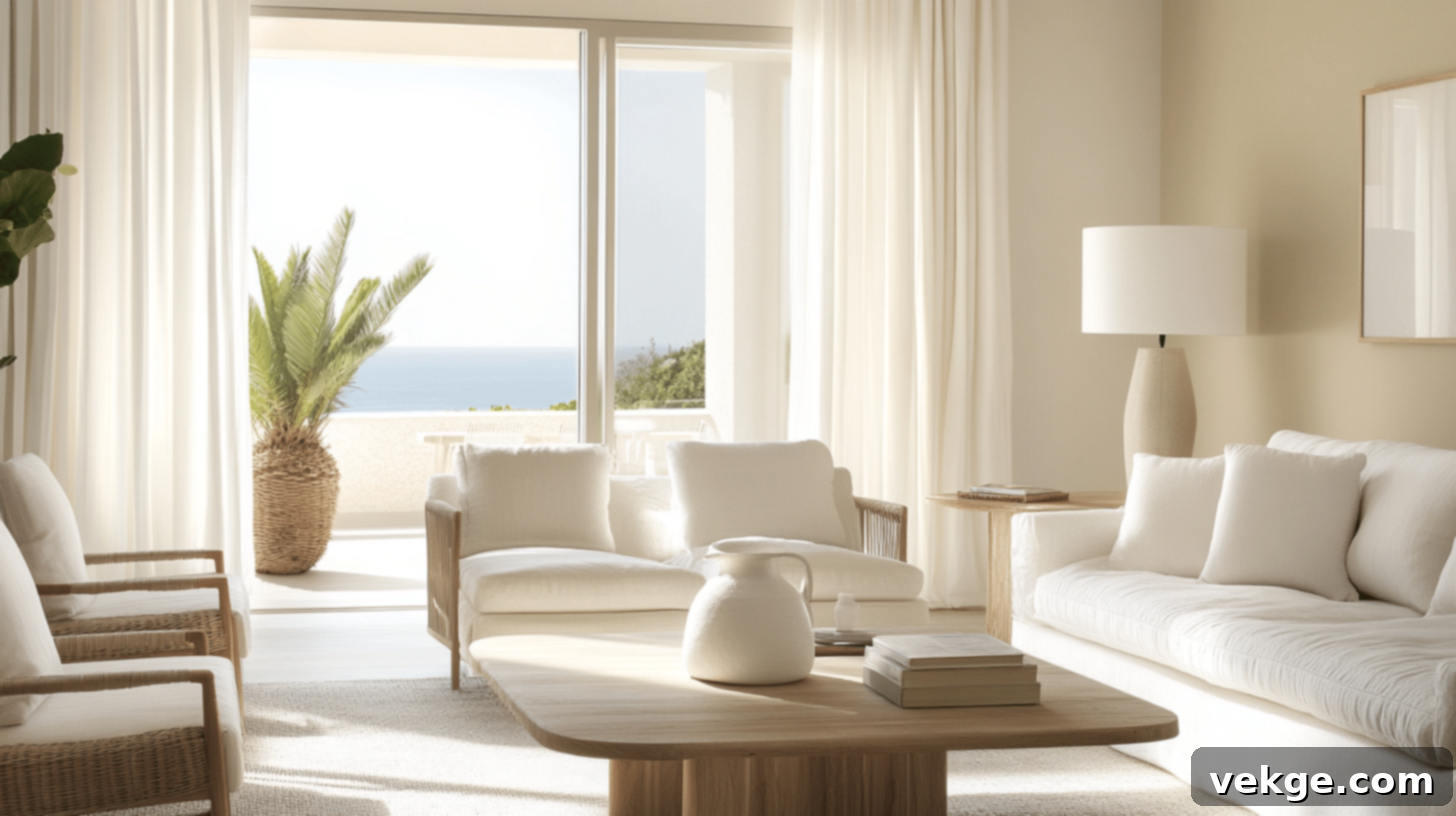Say Goodbye to Yellowish Walls: The Ultimate Guide to Off-White Paints with No Yellow Undertones
Are you frustrated with white paint that unexpectedly takes on a yellow hue, making your walls look dated or dull instead of fresh and bright? You’re not alone. Many homeowners face the challenge of selecting the perfect white, only to find that hidden undertones in the paint transform its appearance under different lighting conditions.
Some white paints are formulated with warm or yellow undertones that become more prominent once applied, leading to that unwanted yellowish tint. The good news is, achieving a truly clean, crisp, and pure white is entirely possible. This comprehensive guide will equip you with the knowledge to identify and choose the best off-white paints that are guaranteed to stay true to their color, free from any yellow hints.
Navigating the world of paint undertones can feel like a daunting task, and many people waste significant time and money on colors that don’t deliver the desired clean and bright effect. We’ll demystify the process, explain why certain whites turn yellow, reveal what to look for in a no-yellow off-white, and provide expert tips to ensure your chosen paint looks flawless in your space. Let’s embark on your journey to perfectly white walls!
Selecting the Right Off-White Paint: Avoiding Yellow Undertones
The quest for the ideal off-white often begins with understanding why some whites betray us by appearing yellow. The culprit is almost always those subtle, hidden undertones. While many white paints inherently carry a touch of yellow or cream to make them feel “warmer,” these can quickly become problematic, especially in certain lighting. Instead of looking fresh and clean, your walls can end up looking old, dingy, or simply ‘off’.
To avoid this common pitfall, focus on off-white paints that boast cooler undertones. These typically have faint hints of gray, blue, or sometimes even a very soft, muted beige that leans cool. These cooler pigments counteract any potential yellowing, ensuring the white remains pure, crisp, and bright on your walls. Think of them as built-in safeguards against unwanted warmth.
The Impact of Natural Sunlight on White Paint
Natural sunlight is a significant factor in how paint colors are perceived, and it can be the biggest instigator of yellow tints in white paint. Rooms bathed in warm afternoon sun, particularly those with a strong western or southern exposure, are more prone to making white paints with warm undertones appear noticeably yellowish. Understanding your room’s orientation is crucial for making an informed paint choice.
Effective Paint Testing Strategies
To truly ascertain an off-white paint’s behavior in your unique space, rigorous testing is indispensable. Here’s a tried-and-true method:
- Compare Against Pure White: Grab a few paint samples and hold them next to a clean, stark white sheet of paper. This immediate comparison will reveal the true undertones. Paints that appear slightly blue or gray compared to the paper are likely to stay whiter on your walls. Those that look creamy or yellowish against the paper should generally be avoided if your goal is a no-yellow white.
- Observe Throughout the Day: Paint large squares (at least 2 feet by 2 feet) of your top two or three choices directly onto different walls in your room. This allows you to see how the color interacts with varying light. Observe these patches at three distinct times: morning, afternoon, and evening. Pay close attention to how the color shifts. If it consistently maintains its clean white appearance throughout the day, irrespective of the changing light, you’ve likely found a winner.
- Consider All Lighting: Don’t forget to evaluate your samples under both natural daylight and your typical artificial lighting. The type of light bulbs you use (warm vs. cool tones) can drastically alter how an off-white appears.
Remember, the ultimate goal is to find an off-white that looks clean and consistent in all lighting conditions. If you spot even a hint of yellow during your testing, it’s a clear sign to continue your search.
Understanding Undertones in Off-White Paint
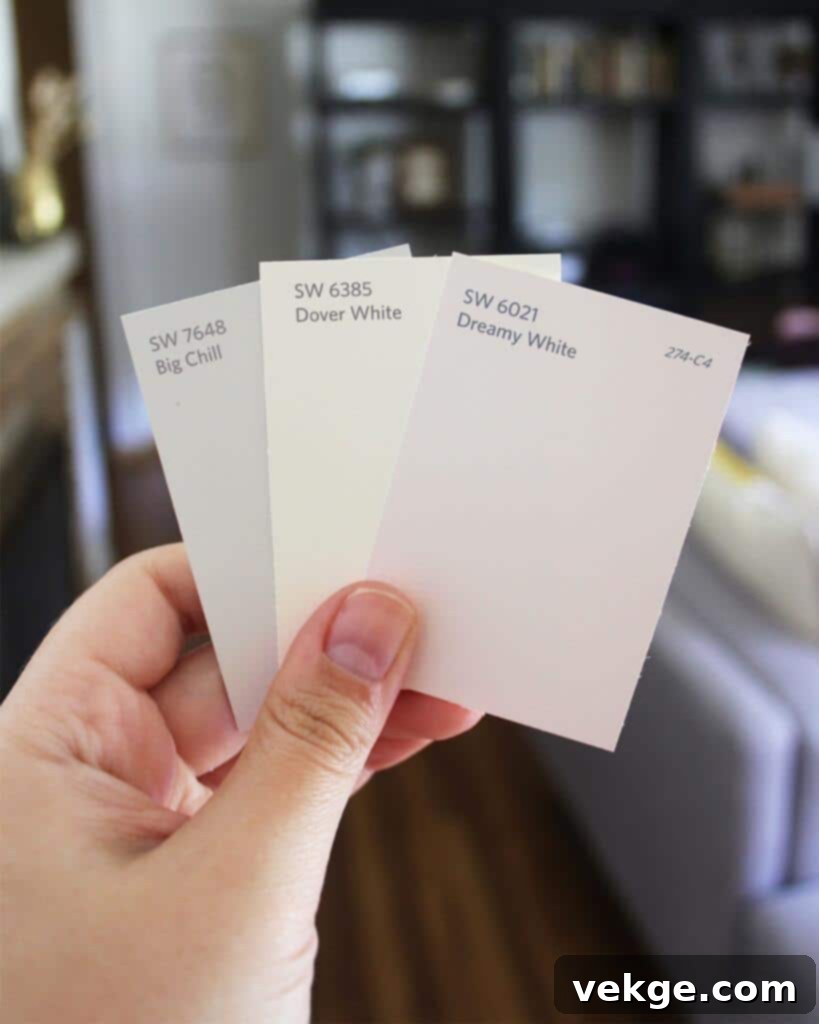
Understanding the fundamental types of undertones is key to making an informed decision:
1. Cool Undertones
- Characteristics: These off-whites will show subtle hints of blue, gray, or sometimes a very faint violet.
- Feeling: They impart a fresh, crisp, and often modern or minimalist feeling to a space.
- Best Use: Work exceptionally well in bright rooms, especially those with southern or western exposure where direct sunlight can lean warm. They also excel in north-facing rooms by counteracting the cool, natural light and still appearing bright without becoming stark.
- Longevity: Tend to stay true to their white color longer and are less prone to yellowing.
- Compatibility: Often complement contemporary decor, metallic accents, and cool color palettes.
2. Warm Undertones
- Characteristics: These whites carry hints of yellow, cream, pink, or beige.
- Feeling: Can make rooms feel cozy, inviting, and traditionally elegant.
- Potential Issue: While often desirable for warmth, if the undertone is too yellow, it might look aged or dingy over time.
- Best Use: Work nicely in rooms with less natural light or a cooler northern exposure, as they can bring a much-needed sense of warmth. Blend beautifully with wooden furniture, earthy tones, and classic styles.
3. Neutral Undertones
- Characteristics: These off-whites strike a perfect balance between warm and cool, with almost imperceptible undertones.
- Consistency: Their greatest strength is staying consistent and true across different lighting conditions throughout the day.
- Versatility: Work exceptionally well in most room settings and interior design styles, making them a safe and versatile choice.
- Detection: Can be the hardest to spot at first glance, requiring careful testing against a pure white background.
The Key to the Perfect Warm White (Without the Yellow)
If you desire a warm white but are adamant about avoiding any yellowing, the secret lies in choosing whites with the right kind of warm undertones. Look for slight hints of pink, soft beige, or greige (gray-beige) rather than overt yellow or cream.
- A slight pink tint can add warmth without the risk of yellowing, often appearing as a gentle blush.
- Beige undertones offer a sophisticated warmth while maintaining a neutral, grounded feel.
- Gray-white bases that have a very subtle warm gray can help control unwanted yellow tints, offering a beautiful balance.
- Crucial Reminder: Testing in your specific space is always paramount. What looks perfect in a designer’s photo might behave differently on your walls.
- Always look at samples during different times of day to capture the full spectrum of light interaction.
Comprehensive Testing Tips
- Paint Large Squares: Apply your chosen samples in generous 2×2 foot squares on at least two different walls in each room you plan to paint.
- Observe Daily Cycles: Watch how the colors evolve from early morning to bright noon and into the evening under both natural and artificial light.
- Compare Rigorously: Hold a clean, white sheet of printer paper or a piece of white poster board directly against your painted samples to highlight any underlying hues.
- Vary Light Sources: Don’t just rely on natural light; turn on all artificial lights (lamps, overheads) to see their effect on the paint.
- Allow Time to Decide: Live with the samples for a few days. Your eyes need time to adjust, and you might notice subtle shifts you missed initially.
Remember: Every room’s unique lighting conditions, adjacent colors, and furnishings can dramatically change how paint undertones appear. What creates a serene atmosphere in one space might feel too cool or too warm in another. This is precisely why thorough testing is the most critical step before committing to painting an entire room.
Optimizing Lighting Conditions for Off-White Paint
The interplay between light and paint color cannot be overstated, especially with off-whites. Understanding your room’s natural and artificial lighting sources is fundamental to achieving the desired effect and ensuring your white paint remains pristine.
Natural Light Effects by Room Orientation:
- North-facing rooms: These rooms receive consistent, cooler, indirect light throughout the day. Off-whites with very subtle warm (pink, beige) or completely neutral undertones work best here to prevent the space from feeling too cold, while still maintaining a clean white. Cool whites can work but may feel stark.
- South-facing rooms: Bathed in bright, warm light for most of the day. This strong, often yellow-toned light can amplify any warm undertones in your paint. Here, off-whites with cool (gray, blue) undertones are your best choice. They will counteract the warm sunlight and ensure the white stays crisp and fresh.
- East-facing rooms: Experience bright, warm morning light, which then fades to cooler, indirect light in the afternoon. Whites with balanced neutral undertones or very subtle cool undertones tend to perform well, maintaining their color truthfulness through the light transitions.
- West-facing rooms: These rooms are the trickiest, receiving soft, indirect light in the morning and intense, warm, golden light in the afternoon and evening. This strong afternoon sun can severely pull out yellow tints from any paint with even a hint of warmth. It’s crucial to select off-whites with pronounced cool (gray or blue) undertones or extremely pure, neutral whites to combat the strong warmth.
Tips for Working with Natural Lighting:
- Test on All Walls: Natural light hits each wall differently, so paint samples on every wall.
- Three-Time Daily Check: Observe your samples in the morning, at noon, and in the evening to capture all light variations.
- Larger Samples: Larger patches provide a more accurate representation of the paint’s final appearance.
- Shadow Play: Note how shadows fall on the walls and how they affect the perception of the paint color.
- Keep Windows Clear: Maximize natural light by avoiding heavy, dark window treatments if possible.
Artificial Lighting Tips:
Artificial lights have their own color temperature, measured in Kelvin (K), which significantly impacts paint appearance. Cool-toned bulbs will enhance cool undertones, while warm-toned bulbs can bring out yellows.
- Pick Cool White LED Bulbs (3000K-4000K): These bulbs emit a neutral to slightly cool light that helps whites appear crisp and clean, reducing the likelihood of yellowing. Avoid bulbs below 2700K if you want to eliminate yellow.
- Avoid Warm Yellow Bulbs (2700K and below): While cozy for some applications, these bulbs will almost certainly make any white paint appear warmer and potentially yellowish.
- Space Lights Evenly: Distribute light sources thoughtfully to eliminate dark corners and create a consistent illumination that showcases your white paint effectively.
- Add Extra Lights in Darker Corners: Strategic task or accent lighting can brighten areas that natural light doesn’t reach.
- Use White-Toned Lampshades: Cream or yellow-toned lampshades will cast a warm glow that can influence the wall color. Opt for crisp white shades for maximum clarity.
Best Light Setups for No-Yellow Whites:
- Mix Natural and Artificial Light: Combine the best of both worlds. Use cool artificial lights to supplement natural light, especially in evenings or on cloudy days.
- Strategic Mirror Placement: Mirrors are excellent for reflecting and amplifying light, making rooms feel brighter and larger, and enhancing the crispness of white walls.
- Layered Lighting: Incorporate ambient, task, and accent lighting at different heights to create depth and ensure even illumination.
Best Off-White Paints with No Yellow Undertone
Here’s a curated list of exceptional off-white paints renowned for their ability to stay true and steer clear of yellowing, along with detailed insights into their characteristics:
1. Benjamin Moore Chantilly Lace (OC-65)
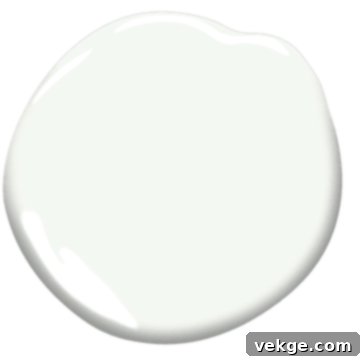
Chantilly Lace is celebrated as one of Benjamin Moore’s purest, cleanest whites, often described as having virtually no discernible undertones. This paint maintains its crisp, true white color with remarkable consistency across various lighting conditions, making it a highly versatile choice for both bright, sun-drenched rooms and more dimly lit spaces. Its absence of yellow ensures it creates a fresh, modern, and inviting look in any interior, from walls to trim.
2. Sherwin Williams Extra White (SW 7006)
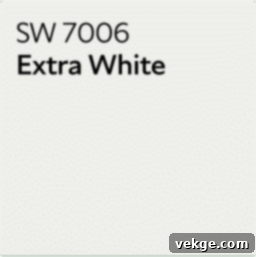
Sherwin Williams Extra White lives up to its name by offering an incredibly crisp and bright white. It possesses a very subtle, almost imperceptible cool undertone, often leaning slightly blue-gray, which is key to preventing any yellowing effects. This quality makes it particularly effective in rooms with abundant natural light, especially those facing south or west. It consistently maintains its clean appearance throughout the day, helping spaces feel larger, more open, and notably brighter.
3. Behr Polar Bear (75)
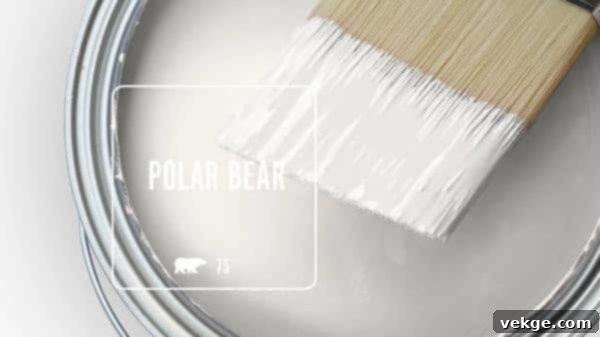
Behr Polar Bear presents a beautiful, soft white that remains remarkably neutral. Its delicate gray undertone is the secret to its clean and consistent look in virtually any lighting situation. This paint is incredibly versatile, blending effortlessly with a wide array of decor styles and furniture choices. It’s an excellent selection for creating a serene backdrop on walls, and it also performs exceptionally well as a trim color.
4. Dunn-Edwards Warm White (DEW380)
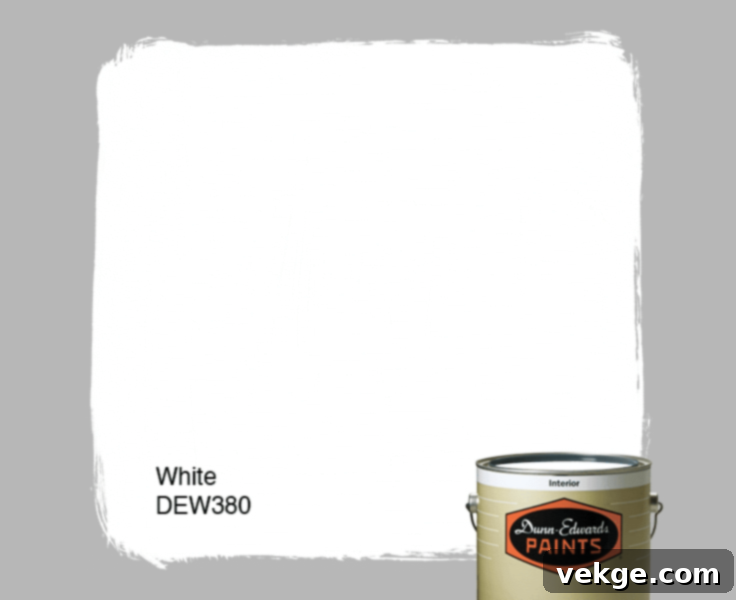
Dunn-Edwards Warm White offers a perfectly balanced approach to white paint, achieving a gentle warmth without any risk of turning yellow. This is thanks to its subtle beige-gray undertone, which provides softness and comfort without leaning too heavily into cream. It helps create a soft, welcoming, and elegant feel in any room, making it an ideal choice for living areas and bedrooms where a cozy ambiance is desired.
5. Farrow & Ball All White (No. 2005)
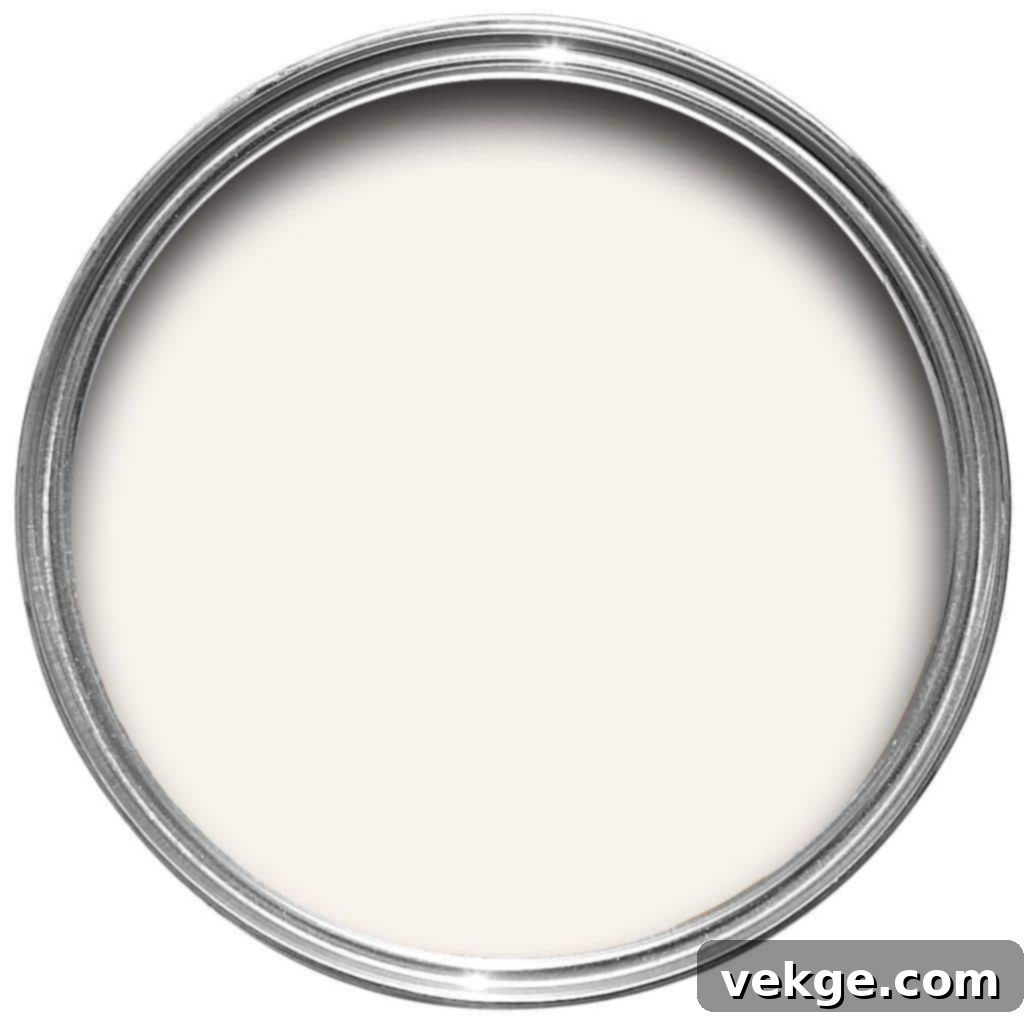
Farrow & Ball All White is celebrated for being a consistently pure white, meticulously crafted without any added pigments, resulting in a clean and unadulterated shade. It has a slight gray undertone that subtly helps it maintain its true white character, even in rooms with warmer natural light, such as west-facing spaces. This paint performs beautifully throughout the day, preserving its fresh appearance and suiting both modern minimalist and classic period home styles.
6. Benjamin Moore White Dove (OC-17)

Benjamin Moore White Dove is a perennial favorite for its ability to deliver a soft yet exceptionally clean white. This paint features a delicate touch of light gray undertone, which effectively keeps the color pure and prevents it from appearing yellow or overly stark. Its remarkable versatility allows it to work well in both brightly sunlit and more shaded spaces, making it a perfect choice for virtually any room in the house where a gentle, bright, and welcoming look is desired without harsh glare.
7. Sherwin Williams Alabaster (SW 7008)

Alabaster is Sherwin Williams’ top-selling white, cherished for bringing a warm, inviting white without succumbing to yellow tints. This paint masterfully balances tiny hints of gray and beige, which create its characteristic warmth while ensuring it remains firmly in the white family. It adapts beautifully to most lighting conditions, maintaining its clean and elegant look throughout the day, and is perfect for fostering a soft, welcoming, and comfortable feel in any space.
8. Valspar Swiss Coffee (7002-16)

Valspar Swiss Coffee is an incredibly versatile and balanced white option that resists yellowing, even when exposed to intense warm lighting conditions, particularly in rooms that receive abundant afternoon sun. Its formulation ensures it stays bright and clean, offering a soft, creamy, and welcoming look without veering into overly yellow territory. It’s an excellent choice for a cozy yet fresh aesthetic.
9. Behr White (52)
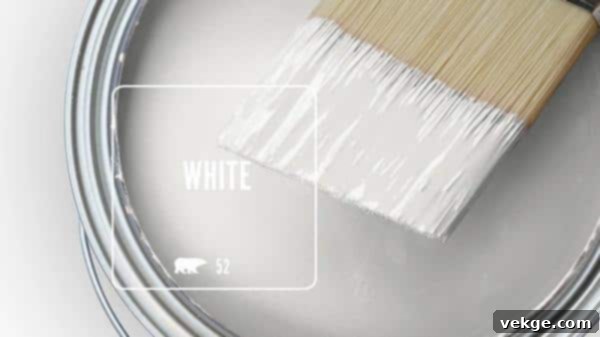
Behr White is a straightforward, pure, and simple white color that delivers on its promise of cleanliness. This paint maintains its crisp, untainted look under both natural daylight and various artificial light sources. It is especially well-suited for modern and minimalist spaces where a true, uncompromised white is paramount. The paint effectively brightens rooms, creating an expansive feel while consistently staying neutral and fresh-looking throughout the entire day.
10. Sherwin Williams Pure White (SW 7005)
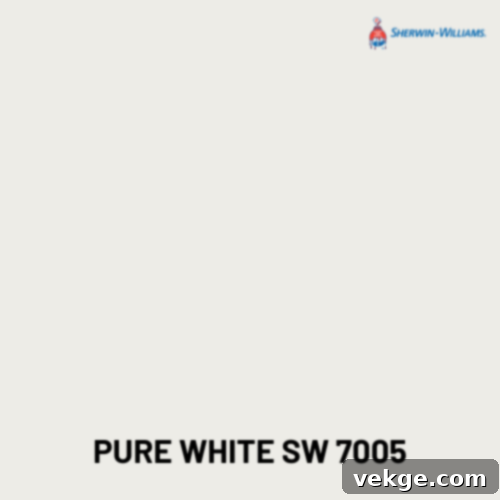
Sherwin Williams Pure White is a highly dependable choice for a clean and genuinely white aesthetic. It features a very subtle, almost unnoticeable hint of gray that acts as a powerful deterrent against yellowing. This paint remains consistently bright and true in both morning and evening light, making it exceptionally versatile. It’s a popular and reliable option for kitchens, living rooms, and bathrooms where a fresh, unblemished, and inviting feel is highly desired.
11. Sherwin Williams Shoji White (SW 7042)

Shoji White offers a soft, inviting off-white shade that expertly avoids yellowing thanks to its subtle hints of gray and beige. These balanced undertones provide warmth without the risk of unwanted yellow shifts, making it look particularly appealing in rooms with ample natural light. It excels at creating a calm, serene feeling and beautifully complements natural materials like wood tones, rattan, and linen, ideal for a relaxed, organic aesthetic.
12. Sherwin Williams White Snow (SW 9541)

Sherwin Williams White Snow is a brilliantly bright and wonderfully clear white paint that truly lives up to its name. This shade is formulated to retain its pristine true color, even when subjected to strong, direct sunlight, making it a robust choice for sun-drenched rooms. It works exceptionally well in any space that demands a clean, crisp, and bright appearance, helping to make rooms feel significantly bigger, more expansive, and openly inviting.
13. Sherwin-Williams Aesthetic White (SW 7035)

Aesthetic White provides a sophisticated and perfectly balanced white look. It features subtle, almost unidentifiable undertones that prevent it from appearing too stark or cold, instead offering a gentle softness. This paint maintains remarkable consistency in different lights throughout the day, adapting beautifully. It gracefully suits both modern minimalist and more classic, traditional room styles, providing a versatile and elegant backdrop.
14. Sherwin-Williams Pearly White (SW 7009)

Pearly White by Sherwin-Williams delivers a gentle and luminous white tone. Its delicate light gray undertones are carefully balanced to ensure the paint stays true to its color, preventing any unwanted yellowing while still offering a sense of warmth. This paint performs beautifully throughout the entire day and is a suitable choice for most room types, creating a soft, inviting glow that makes spaces feel truly welcoming and comfortable.
15. Benjamin Moore Super White (OC-152)

Benjamin Moore Super White is a brilliantly bright and ultra-clean white paint that stands as a testament to pure, unadulterated white. It is meticulously formulated to remain a true white, completely free from any yellow or warm undertones showing through, even under challenging lighting. This paint excels in modern spaces and rooms flooded with natural light, helping to create incredibly sharp, clean-looking walls, ceilings, and trim, offering a gallery-like backdrop.
How to Enhance Your Space with Off-White Paint
Once you’ve chosen your perfect no-yellow off-white, here are some simple yet impactful ways to maximize its beauty and transform your home.
Thoughtful Color Combinations
- Soft Blues for Freshness: Pair off-white walls with muted blues in textiles or decor for an instantly fresh, airy, and coastal-inspired feel.
- Light Grays for Balance: Introduce light gray furniture, rugs, or accessories to create a sophisticated and balanced palette that enhances the off-white’s clean lines.
- Natural Browns for Warmth: Utilize natural wood tones, leather, or earthy brown accents to inject warmth and grounding without introducing yellowing elements.
- Black for Modern Contrast: Create a striking, contemporary look by pairing off-white walls with crisp black accents in lighting, frames, or furniture.
- Green Plants to Bring Life: Incorporate living green plants. Their natural vibrancy beautifully contrasts with off-white, adding organic texture and life to the room.
Room-by-Room Application Tips
Living Room
- Brighter Trim: Paint your trim a slightly brighter, more pure white than your off-white walls to create subtle definition and a polished look.
- Softened Ceilings: Consider using the same off-white on ceilings to create a seamless, expansive feel, softening the overall light distribution.
- Curtain Coordination: Match curtains closely to your wall color for a cohesive, flowing aesthetic that makes the room feel larger and more unified.
Kitchen
- Pure White Cabinets: If your walls are off-white, pure white cabinets can provide a crisp, clean contrast.
- Light, Clean Backsplash: Choose a backsplash that is light and complements the off-white without being too stark or introducing clashing undertones.
- Countertop Harmony: Select countertops whose undertones (cool or neutral) align with your chosen off-white paint for a cohesive design.
Bedroom
- Monochromatic Walls: Paint all walls the same restful off-white to create a serene, enveloping sanctuary conducive to relaxation.
- White Bedding: Incorporate layers of white bedding and textiles to tie the room together and enhance the calming effect.
- Light Window Frames: Keep window frames light and bright to maximize natural light and maintain an open, airy feeling.
Making Spaces Feel Bigger
- Seamless Baseboards: Paint baseboards the exact same off-white color as the walls to eliminate visual breaks and make the room appear taller.
- Cohesive Trim: Keep window trim, door frames, and doors consistent with the wall color or a very subtle shade lighter to enhance spaciousness.
- Ceiling Continuity: Painting the ceiling the same off-white as the walls extends the visual height of the room, creating an illusion of boundless space.
- Consistent Hardware: Use consistent finishes for door handles, hinges, and light fixtures to maintain a streamlined, uncluttered look.
Refining Lighting Effects
- Corner Lamps: Strategically place floor or table lamps in room corners to spread light evenly and eliminate dark spots, making the off-white appear brighter.
- Cool White Bulbs: Continue to use cool white LED bulbs (3000K-4000K) to reinforce the clean, no-yellow appearance of your walls.
- Reflective Mirrors: Add large mirrors opposite windows or light sources to bounce light around, enhancing brightness and the true color of the paint.
- Unobstructed Windows: Ensure windows are kept as clear as possible to allow maximum natural light penetration.
- Even Light Distribution: Plan your lighting layout to avoid harsh shadows and ensure the off-white is consistently illuminated.
General Painting Reminders for a Flawless Finish
- Cleanliness is Key: Always ensure walls are thoroughly cleaned before painting; dirt and grease can affect paint adhesion and appearance.
- Prep Work Pays Off: Proper preparation, including sanding, patching, and taping, is crucial for a professional, long-lasting finish.
- Lighting is Paramount: Never underestimate the power of light. It’s the most significant factor in how your chosen off-white will look.
- Quality Paint Matters: Investing in high-quality paint not only provides better coverage but also ensures durability and color consistency over time.
- Two Coats Minimum: Always apply at least two full coats of paint for rich, even color and optimal coverage; often, three coats are even better for whites.
Avoid Common Mistakes When Choosing Off-White Paint
Even with the best intentions, it’s easy to make missteps when selecting and applying off-white paint. Being aware of these common errors can save you time, money, and frustration:
- Not testing paint samples in your actual room lighting: This is the most critical mistake. Store lighting is vastly different from your home’s unique light.
- Skipping primer on your walls: Primer is essential for even coverage, better adhesion, and blocking old colors or stains from bleeding through.
- Picking white paint based only on how it looks in the store: Never rely solely on small swatches under artificial store lights.
- Not checking the paint at different times of day: Light changes hourly, and so does the appearance of your paint.
- Using warm light bulbs with cool white walls: Warm bulbs (low Kelvin) will introduce yellow tones, negating your efforts to achieve a no-yellow white.
- Forgetting to look at the paint against existing white items: Compare your samples to baseboards, trim, or existing appliances to ensure harmony.
- Not preparing walls properly before painting: Dirt, dust, and imperfections will show through, compromising the final look.
- Using cheap brushes or rollers that leave marks: Quality tools make a significant difference in the smoothness and professionalism of the finish.
- Applying only one coat of paint: Especially with lighter colors, one coat will almost always appear streaky and lack depth.
- Not considering your room’s direction and natural light exposure: This leads to choosing a white that clashes with the inherent light warmth or coolness.
Quick Fix Tips to Ensure Success:
- Always use large paint samples on each wall.
- Opt for cool-toned LED light bulbs (3000K-4000K).
- Thoroughly clean walls before painting.
- Invest in quality brushes and rollers.
- Always apply at least two full, even coats.
- Start with a good quality primer, especially on new or dark walls.
- Test paint samples exclusively in your real room light.
- Check paint samples both morning and night.
- Evaluate large sample areas, not just tiny swatches.
- Actively consider your room’s directional light exposure.
Conclusion: Achieve Your Dream of Crisp, Clean White Walls
The journey to finding the perfect off-white paint that truly stays clean and fresh, without any dreaded yellow undertones, requires careful consideration and a methodical approach. While it might seem like a detailed process, the effort is undeniably worth it for the lasting beauty and serenity it brings to your home.
By understanding the nuances of paint undertones, recognizing the profound impact of both natural and artificial lighting, and diligently employing effective testing strategies, you can confidently select a white that elevates your space. Remember, even the smallest rooms can be transformed to feel larger, brighter, and more inviting with the right off-white hue.
Let’s briefly recap the essential takeaways for your perfect white:
- Always test paint samples directly in your actual room.
- Observe how colors change at different times of day.
- Critically consider your room’s directional exposure for natural light.
- Opt for cool-toned LED bulbs (3000K-4000K) to enhance clarity.
- Always apply a minimum of two coats for the best, most consistent results.
- Do not skip a high-quality primer for a flawless foundation.
Take your time with the selection and testing process. With these expert tips and a curated list of top-performing off-white paints, you are well-equipped to find the ideal white that will create a lasting impression of cleanliness, elegance, and openness in your home. Say goodbye to yellowed walls and hello to a beautifully fresh interior!
Have more questions about choosing the right white for your space? Feel free to leave a comment below!
